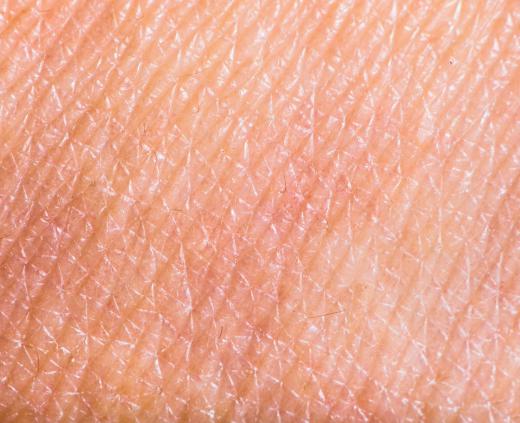How does the Sense of Touch Work?
 Michael Anissimov
Michael Anissimov
Touch is actually a combination of various somatic senses, including the sensations of temperature, pressure, and pain; kinesthetic senses that give humans a conception of their body in space (proprioception); and visceral senses, such as stomach aches or nausea. The information from these senses is processed in the postcentral gyrus, corresponding roughly to the top middle area of the brain. The postcentral gyrus, or parts of it, are often referred to as the primary somatosensory cortex, and this area gets more direct sensory input information than any other in the brain.
Along with the sense of smell, touch is one of the most primitive and universal of sensory apparatuses in the kingdom of life. Almost all animals use it to navigate complex environments, appraise their immediate surroundings, and detect the presence of food.

In humans, much of the somatosensory cortex is devoted to processing signals from the hands and face — about 90%. The feeling in these "sensory hot spots" is correspondingly sensitive and high-resolution. A palm can detect the presence of an object only weighing a fraction of a gram. Glabrous or hairless skin contains the finest receptors, called mechanoreceptors, and they translate physical force into nerve impulses. The main four mechanoreceptors in hairless skin areas are Pacinian corpuscles, Meissner's corpuscles, Merkel's discs, and Ruffini corpuscles.

Different mechanoreceptors are specialized to detect different touch sensations, and they can be found at a variety of different depths in the skin. Some mechanoreceptors, such as the Pacinian copulscule, which detects deep pressure and high frequency vibrations, are as large as 0.039 inches (1 mm). Meissner's corpuscles, responsible for light sensations, are about 20 times smaller and located much closer to the surface of the skin.

Free nerve endings, the most common type of skin receptor, are cell-sized and do most of the work of the somatosensory system. The method of using a free nerve ending for touch reception is very old evolutionarily — the basic principle has not changed since the most primitive forms of multicellular life emerged about 600 million years ago.
AS FEATURED ON:
AS FEATURED ON:














Discussion Comments
Hairless skin more sensitive than hairy? Wrong.Hairs, with their follicles *are* sensory mechano-receptors. They extend our sense of touch beyond the skin into the air surrounding us. The brush of cloth, the irritation of a buzzing insect - the sensations come from the hairs at least as much as direct contact with the skin.
Montagna observed in "Evolution of Human Skin" that hair follicles are richly enervated (packed with the receptors mentioned) and represent the principle component of the skin's tactile sensitivity.
When it comes to mechano receptors, the hair and follicle package beats the glabrous hairless skin hands down; it takes our sense of touch beyond the surface of the skin into the air beyond it. Bugs are annoying you? Chances are it's the hairs that are making those sensations and the bugs don't even have to touch them; hairs are so sensitive to air movements the wind off a passing insect is easily felt.
It's way past time the "useless vestige" thing with body hair got put to rest. Although it could be a great test study for cognitive dissonance. There are eminent experts who think hairs on arms or legs have no survival function yet swat at biting insects they only felt because useless hairs were disturbed. --Ken F.
Why would it have changed? The human brain on this world is the same as that of those that visit this world. The foundation stones of life -- natural laws -- are prevalent across the universe, and don't change with belief systems, myths or lack of clarity.
Instinct evolution, and intelligence evolution, should never be complicated with consciousness evolution, both of which are associated with the lower and higher animals. Only the human evolves the consciousness. Therefore we will never change our form to the extent of changing these fundamentally. We never came from monkeys, for the natural laws are fixed and cannot be bent, broken or mixed.
But you can delude yourself. That is very real and possible. Take a look at nature before you make any assumptions like the Darwin model or the Christian model. Factor in yeti DNA, the age cap, the asteroid belt, the more than natural three races on earth. Planets only create three races, and earth has GM adonis.
@cafe41: This is because having a pet can reduce negative stress and its harmful effects, thus making a person live longer.
@anon265150: It is possible to create an image of something that isn't real in someone's brain by stimulating nerves with electricity, but you would have to go through the optical nerve (the nerve bundle from the eyes to the brain). It is even possible to plug in a camera to a blind person's optical nerve (depending on how they became blind) and have them see through it.
The post is really interesting. I am inquisitive about some other aspects of the touch sense. Is it possible to send electrical signals through the touch receptors on the skin to create an image on the brain of something that is actually not there?
@Latte31- I heard that too, and I also heard that when elderly people pet animals their blood pressure goes down and they actually live longer. This is why they have pet therapy in many hospitals so that the elderly patients will improve their health.
I think that the sense of touch does improve one’s quality of life in general because it does feel nice to pet a dog or hug someone.
@Spanishink – I agree. What I think is amazing is how sometimes a person in a coma can respond to a sense of touch. I was reading that even when a person is in a coma, they are able to hear those around them and by touching their hand they can also feel someone around them.
They may not be able to respond back but they really do feel it. The sense of touch is really a nice way to communicate with a loved one that is unconscious like this and knowing that they can feel when you do hold their hand makes me feel better.
Quite incredible, don't you think?
Touch is one of the most evocative senses and, along with smell, it certainly is one that is almost impossible to capture on film.
Post your comments